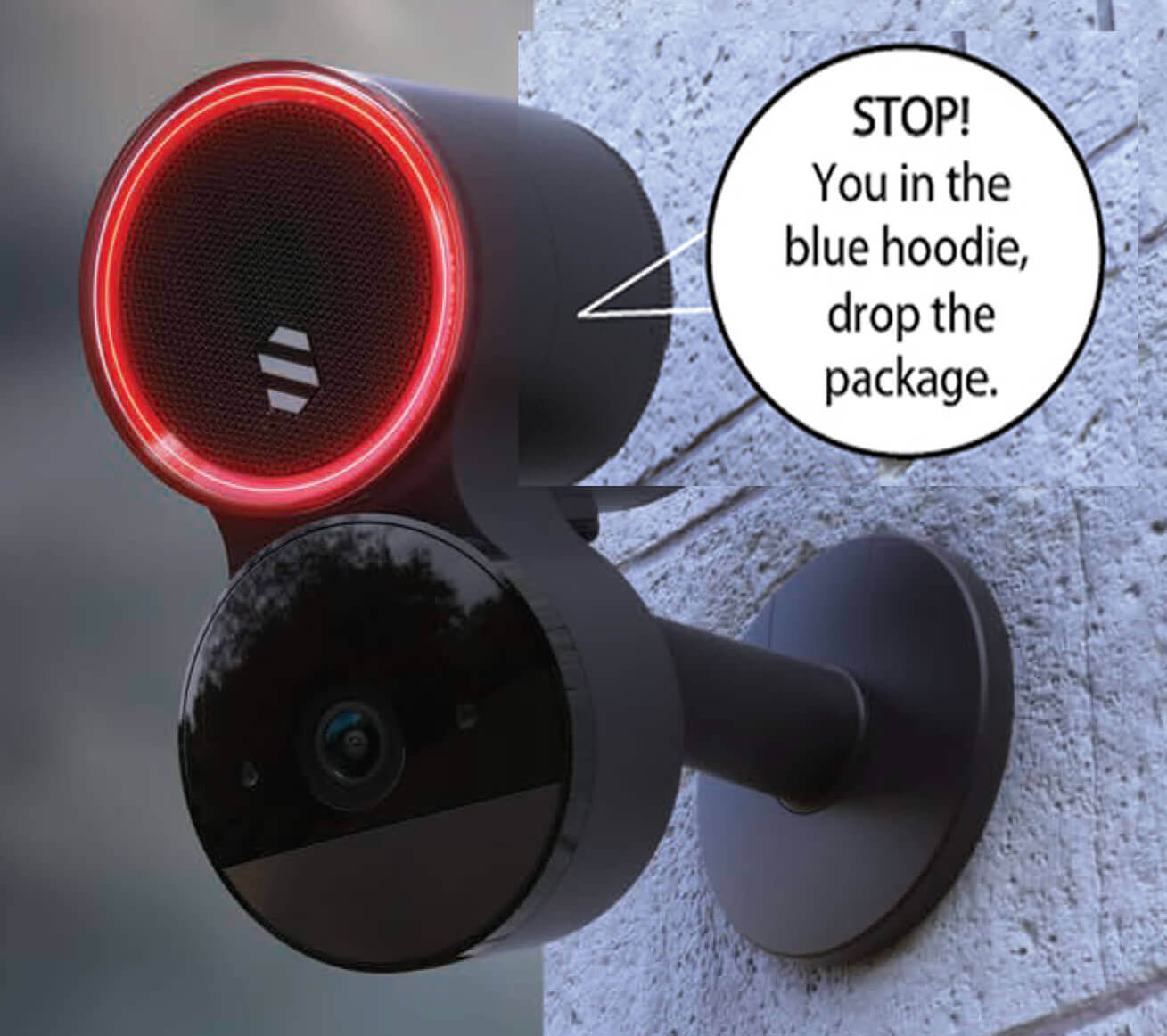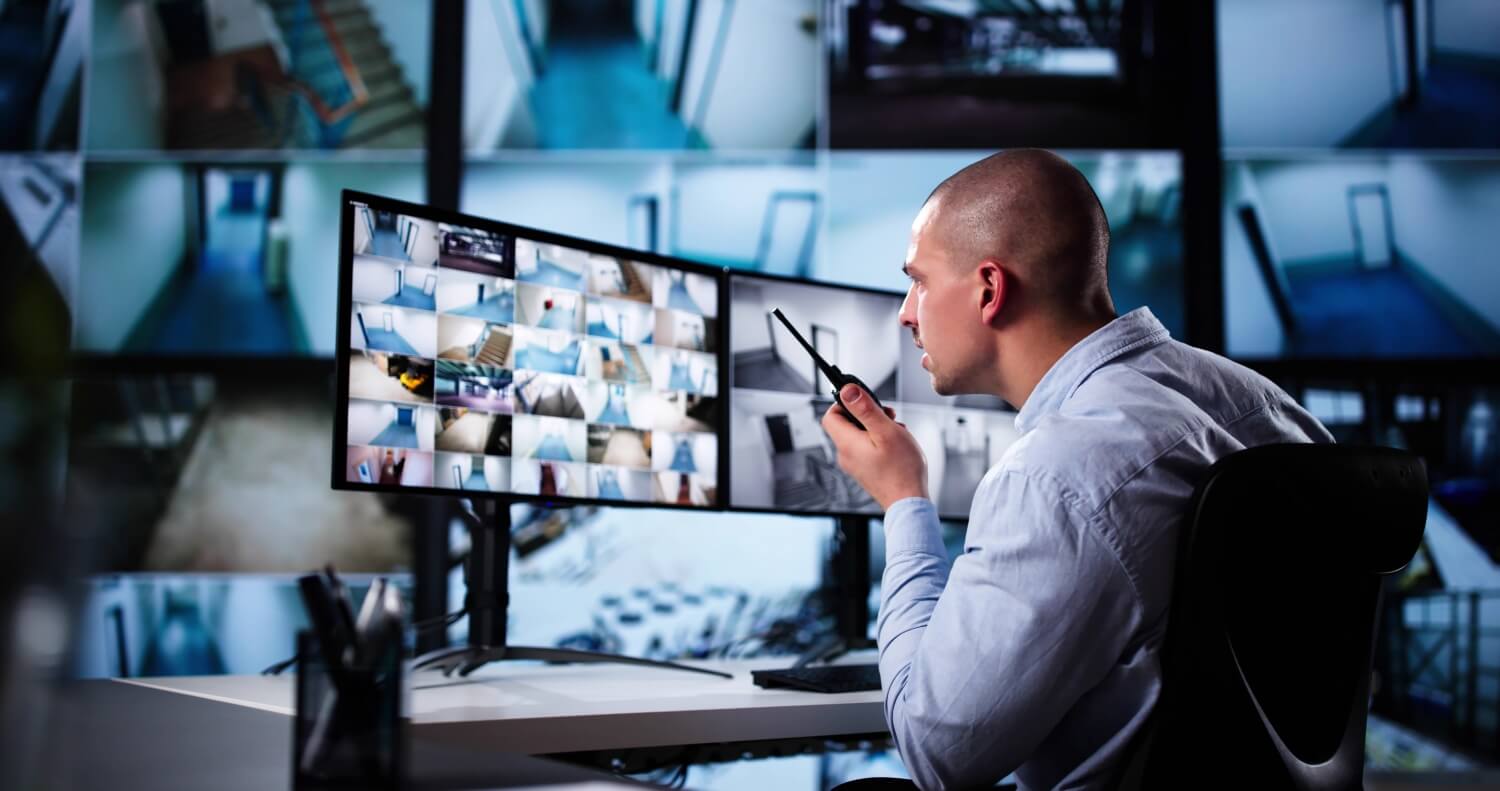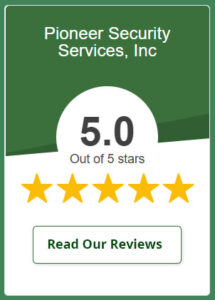AI-powered live video monitoring and two-way voice communication are transforming security operations by combining real-time surveillance with direct human intervention. AI enhances monitoring systems by analyzing video feeds for unusual activity, enabling immediate alerts and responses. Two-way voice features allow security personnel to communicate directly with individuals on-site, providing real-time deterrence and guidance.
The adoption of AI in security is accelerating. According to a report by Mordor Intelligence, the AI in security market is projected to grow from USD 30.02 billion in 2025 to USD 86.34 billion by 2030, reflecting a compound annual growth rate (CAGR) of 22%.
This article will explore the integration of AI in live video monitoring systems, focusing on its role in enhancing situational awareness and response times. Additionally, we will examine the effectiveness of two-way voice communication in preventing security breaches, highlighting case studies and best practices. By understanding these technologies, organizations can better protect their assets and respond proactively to potential threats.
Understanding AI in Live Video Monitoring
AI-powered live video monitoring systems are revolutionizing security by integrating advanced technologies to analyze and interpret video feeds in real-time. These systems utilize features such as object recognition, behavior detection, and anomaly alerts to enhance surveillance capabilities.
Object recognition allows the system to identify and classify objects within the video feed, such as people, vehicles, or packages. Behavior detection analyzes patterns of movement to discern normal activities from suspicious ones. Anomaly alerts notify security personnel of any deviations from established norms, enabling prompt responses to potential threats.
The Role of Machine Learning in Threat Detection
Machine learning (ML), a subset of AI, plays a crucial role in enhancing security systems. By continuously learning from data, ML algorithms can detect patterns and anomalies that may indicate security threats. For instance, ML can identify unusual network traffic or unauthorized access attempts, allowing for timely intervention. Over time, these systems improve, becoming more adept at distinguishing between legitimate and malicious activities.
Reducing False Alarms with AI
One of the significant challenges in traditional security systems is the high incidence of false alarms, which often results in alert fatigue among security personnel and wasted response resources. AI-powered systems mitigate this issue by incorporating contextual awareness, pattern recognition, and real-time decision-making into alert mechanisms.
For example, advanced AI algorithms can distinguish between harmless events, such as an animal moving across a yard or leaves blowing in the wind, and genuine threats, like unauthorized entry or suspicious behavior. Some systems even analyze object size, speed, and trajectory to reduce misidentifications further.
False alarm rates in traditional security systems can range from 90% to 99%, often resulting in wasted resources and delayed responses. AI-powered security systems address this challenge by using advanced algorithms and machine learning to accurately distinguish real threats from benign activities, such as pets, passing vehicles, or environmental motion.
Predictive Analytics in Security Monitoring
Predictive analytics leverages historical security data, environmental context, and advanced statistical models to anticipate potential incidents before they occur. By continuously analyzing patterns such as peak activity hours, previous intrusion attempts, and movement trends, predictive models can highlight areas and times of elevated risk.
This allows security teams to proactively allocate resources, for instance, increasing patrol frequency around vulnerable entrances or adjusting camera focus during high-risk periods. Some AI-driven systems integrate real-time external data, like weather conditions or public events, to refine predictions further.
According to the Security Industry Association, organizations applying predictive analytics report a measurable reduction in security breaches and more efficient use of monitoring personnel. Essentially, predictive AI shifts security operations from a reactive model to a proactive, intelligence-driven approach, improving both safety outcomes and operational efficiency.
What Is Two-Way Voice in Live Video Monitoring?

What Is Two-Way Voice in Live Video Monitoring?
Two-way voice, also called two-way audio, is a feature in modern security cameras that allows operators to communicate directly with people on-site in real time. Unlike traditional systems that only record video, two-way voice lets security personnel or property managers speak through the camera using a connected app or monitoring station. This capability is valuable for interacting with visitors, guiding delivery personnel, or addressing suspicious individuals immediately, providing an active layer of security instead of purely passive surveillance.
Essentially, two-way voice transforms a surveillance system from a passive observer into an interactive security tool, allowing operators to respond instantly as events unfold.
How Two-Way Voice Works to Deter Criminal Activity
Once a potential threat is detected, two-way voice allows operators to take immediate, interactive action, turning passive surveillance into proactive intervention. Below is a short overview of how the system actually works,
- Detection of Suspicious Activity: The system’s cameras, often AI-enhanced, continuously monitor the area. When unusual motion or behavior is detected, the operator is alerted in real time.
- Immediate Human Interaction: Once alerted, the operator can speak directly to the individual through the camera’s built-in speaker, creating the impression of live human oversight.
- Issuing Authoritative Warnings: The operator delivers voice-down commands, warning the person that they are being watched and that authorities may be notified. This step leverages the psychological effect of accountability to discourage further activity.
- Disruption of Criminal Intent: Hearing a human voice unexpectedly can startle or confuse intruders, making them more likely to abandon their actions.
- Coordination with Emergency Response: While communicating with the individual, the operator can simultaneously alert law enforcement or on-site security, ensuring a faster and safer response.
How Two-Way Voice Improves Customer and Employee Safety
In addition to deterring crime, two-way voice enhances safety for employees, customers, and residents:
- Business Environments: Operators can guide visitors, assist employees during emergencies, or prevent accidents in parking lots and warehouses.
- Residential Properties: Homeowners can communicate with delivery personnel, warn intruders, or check on family members without leaving their property.
- Real-Time Problem Solving: Quick intervention through voice reduces response time for incidents, improving overall safety and satisfaction
How AI and Two-Way Voice Work Together in Security
The integration of AI-powered detection and two-way voice communication creates a dynamic security system that not only identifies threats but also actively deters them. This synergy transforms traditional surveillance into a proactive security solution.
1. Real-Time Threat Identification and Voice Intervention
AI-driven cameras continuously monitor environments, using advanced algorithms to detect unusual activities. Upon identifying a potential threat, the system alerts a security operator. The operator can then issue a live voice command through the camera’s built-in speaker, directly addressing the individual and warning them of the detected surveillance. This immediate human intervention significantly increases the likelihood of deterring criminal behavior.
2. Faster Response and Reduced Police Dispatch Time
Traditional security systems often rely on delayed police responses, which can be ineffective in preventing crimes in progress. In contrast, AI systems with two-way voice capabilities enable real-time verification of threats, significantly enhancing the efficiency of law enforcement efforts.
A Deloitte study found that smart technologies, including AI, could help cities reduce crime by 30% to 40% and decrease emergency response times by 20% to 35%.
These advancements underscore the transformative impact of AI and two-way voice systems in enhancing public safety and optimizing law enforcement operations.
3. Case Studies of AI and Two-Way Voice Preventing Crimes
Some real-life case studies of how AI and two-way voice prevent crimes are,
Retail Sector:
Retailers face significant challenges with theft and fraud, leading to substantial financial losses. According to the National Retail Federation, U.S. retailers lost over $112 billion to organized retail crime in 2023. AI-powered surveillance systems equipped with two-way voice capabilities have proven effective in mitigating these losses.
AI-powered surveillance systems equipped with two-way voice capabilities have proven effective in mitigating these losses. These systems utilize advanced algorithms to detect suspicious activities and enable real-time communication with potential offenders, deterring theft before it escalates.
Financial Institutions:
Financial institutions are prime targets for sophisticated fraud attempts, including voice cloning, deepfakes, and account takeover schemes. To counter these threats, banks and fintech companies are increasingly adopting AI-driven voice biometric systems, which analyze unique voice patterns to verify identities in real time.
A leading UK bank implemented AI-powered voice authentication to detect and prevent fraud. As a result, up to 90% of attempted frauds were blocked before completion, significantly reducing financial losses and improving customer confidence
Benefits of Using AI and Two-Way Voice in Monitoring

Modern security has moved beyond passive cameras and alarms. AI-powered monitoring combined with two-way voice communication transforms traditional systems into proactive, intelligent solutions that enhance safety, efficiency, and overall experience for businesses, residential communities, and public spaces. Below are some of the major benefits that make AI and two-way voice monitoring a smarter choice for modern security:
1. Cost Savings Compared to Security Guards
Maintaining full-time security personnel for 24/7 coverage is expensive, particularly for businesses with multiple sites. According to the U.S. Bureau of Labor Statistics, the median annual wage for a security guard was $38,370 in May 2024, with the lowest 10% earning under $29,800 and the highest 10% exceeding $59,580. These costs can quickly add up when factoring in benefits, overtime, and coverage across multiple locations.
In contrast, AI-powered monitoring systems with two-way voice can provide comprehensive, real-time security coverage at a fraction of the cost. These systems can oversee multiple locations simultaneously, detect suspicious behavior instantly, and enable operators to communicate directly with visitors or intruders, all without the recurring expense of multiple full-time guards.
2. Higher Accuracy and Proactive Security
Traditional CCTV systems are reactive, recording events for later review. AI-driven monitoring, however, analyzes activity in real time, detecting unusual behavior, anomalies, and potential threats immediately. Verified AI alerts can reduce false alarms by up to 75%, allowing security teams and law enforcement to respond efficiently and effectively.
Predictive analytics further enhances security by identifying patterns, such as repeated loitering or unauthorized access, allowing operators to intervene proactively before incidents escalate.
3. Enhanced Customer Experience in Business Properties
Two-way voice systems do more than prevent crime, they improve interactions with customers, employees, and visitors. Security operators can communicate directly in real time to assist shoppers, guide deliveries, verify residents’ visitors, or provide urgent support.
This level of engagement enhances both safety and user satisfaction, creating a professional and responsive environment that builds trust and confidence.
Challenges of AI and Two-Way Voice Technology
While AI and two-way voice monitoring offer significant advantages in modern security, these systems are not without their challenges. Businesses and communities need to understand potential limitations and implement strategies to mitigate them to maximize effectiveness and compliance.
Privacy Concerns and Legal Regulations
One of the primary challenges of AI-powered video monitoring and two-way voice communication is privacy compliance. Many jurisdictions, including the European Union, enforce strict regulations such as the General Data Protection Regulation, which governs the collection, storage, and processing of personal data.
Individual states have their own privacy laws in the United States, such as the California Consumer Privacy Act (CCPA), which requires organizations to ensure transparency and obtain consent where necessary.
Technical Reliability and Network Dependence
AI and two-way voice systems rely heavily on stable network connections and sufficient bandwidth. Downtime or connectivity issues can temporarily disable monitoring, leaving properties vulnerable. Additionally, hardware or software malfunctions can affect the accuracy of AI detection or delay voice communication.
To mitigate these risks, organizations should invest in redundant systems, reliable internet infrastructure, and regular maintenance. Backup power supplies and failover protocols also help ensure continuous operation in case of outages.
Training Operators for Effective Voice-Down Use
Even the most advanced AI and two-way voice systems require a trained human element to function optimally. Operators must know when and how to use voice-down commands effectively, maintaining professionalism while ensuring compliance with local laws and company policies.
Without proper training, operators may overreact to benign situations or fail to intervene in critical moments. Regular training programs, performance reviews, and scenario-based exercises can help staff respond confidently, ethically, and effectively in real-time situations.
Protect What Matters Most with AI and Two-Way Voice
AI and two-way voice technology are revolutionizing security monitoring. By combining real-time AI detection with direct human intervention, these systems enhance accuracy, reduce false alarms, and provide proactive protection across businesses, residential communities, and public spaces. From deterring intruders and preventing theft to improving customer and employee safety, the synergy of AI and two-way voice ensures a smarter, more efficient, and responsive security solution for modern environments.
For organizations looking to upgrade their security infrastructure, partnering with a trusted provider like Pioneer Security can make the implementation seamless. Their AI-powered monitoring solutions with two-way voice capabilities help businesses and communities maximize safety, reduce costs, and benefit from advanced real-time protection. Learn more about how Pioneer Security can transform your security strategy today.
Frequently Asked Questions
How Does AI Improve Live Video Monitoring Accuracy?
AI improves live video monitoring by enabling real-time object recognition, behavior analysis, and anomaly detection. Unlike traditional CCTV that relies on human operators to notice unusual activity, AI can identify people, vehicles, and suspicious behaviors automatically. This significantly reduces false alarms, ensuring that security personnel respond only to verified threats.
Is Two-Way Voice Effective in Stopping Intruders?
Yes, two-way voice is highly effective in deterring intruders. When security operators communicate directly with a potential threat in real time, often referred to as voice-down intervention, it has a psychological deterrent effect. Retailers and construction sites have reported significant reductions in theft and vandalism after implementing two-way voice systems.
Can AI Replace Human Security Operators Fully?
While AI significantly enhances monitoring capabilities, it cannot fully replace human operators. AI excels at detecting anomalies, analyzing patterns, and alerting staff, but human judgment is still essential for interpreting context, making ethical decisions, and issuing real-time voice commands.
What Businesses Benefit Most from Two-Way Voice?
Businesses that face high traffic, theft risk, or safety concerns benefit the most. Retail stores use it to prevent shoplifting and assist customers, construction sites employ it to protect equipment, and residential communities use it for visitor verification and emergency assistance.
Is Two-Way Audio Legal in All States?
The legality of two-way audio varies by jurisdiction. Businesses must comply with federal, state, and local privacy laws, including consent requirements for audio recording. GDPR compliance is mandatory in the EU. Companies must implement clear privacy policies and obtain consent where necessary to remain compliant.
How Much Does AI-Powered Monitoring Cost?
Costs vary depending on the system’s features, number of cameras, and level of AI integration. Basic AI monitoring packages can start around $50–$100 per camera per month, while fully integrated solutions with two-way voice, predictive analytics, and cloud storage can exceed $300 per camera per month.



